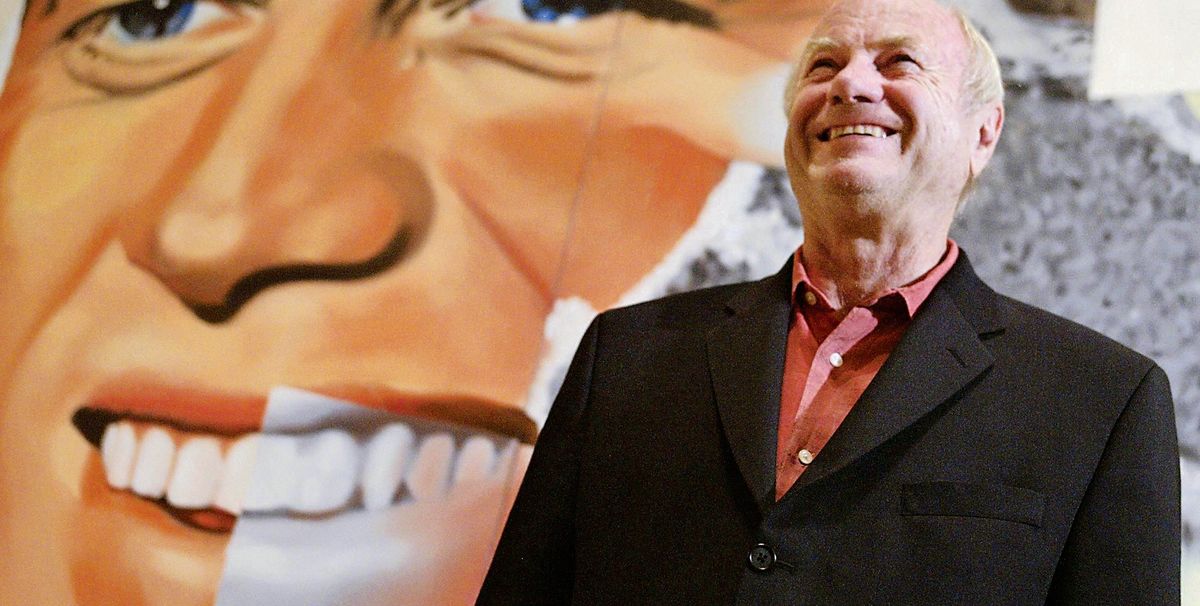James Rosenquist, a key figure in American Pop art, died in New York on 31 March, aged 83.
Born in North Dakota and raised in the American Midwest, Rosenquist attended the Minneapolis Institute of Arts on a scholarship. Two more years of art studies followed at the University of Minnesota, but Rosenquist’s most important career preparation came from his work as a painter of commercial signs and billboards, between 1956 and 1960.
From billboards to New York After settling in New York, initially on a stipend to study at the Art Students League, and bent on becoming an abstract painter, he moved to a Lower Manhattan studio building where Ellsworth Kelly, Robert Rauschenberg, Jasper Johns and Jack Youngerman were immediate neighbours. The milieu emboldened Rosenquist to steer his studio work away from “tiny” abstractions, as he described them, toward the imagery and techniques he had mastered as a billboard painter. Rauschenberg and Johns reinforced his interest in pictures with vernacular content. The works of Kelly and Youngerman offered examples of the proclamatory power of simple abstract forms. “I began to realise,” Rosenquist told an interviewer in 1991, “that my style of painting billboards had an accuracy and a grandeur. It might have been kitsch, but it had a strength to it.”
Rosenquist quickly evolved an enigmatic, high-impact manner of setting in collision fragmentary images of comestibles and other consumer goods, readily recognised but infrequently scrutinised by a wide public. He answered critics who likened his work to Surrealism, little of which he had set eyes on, by pointing out the crucial difference that his paintings’ scale made. Early gallery and press exposure led to his work being tagged as New Realism, before the label of Pop art, which he never avowed, settled on it and that of contemporaries such as Johns, Andy Warhol, Tom Wesselmann and Claes Oldenburg.
Vietnam and the Bomb I never met Rosenquist, but I encountered his work first at what today seems to have been a formative moment both in late 20th-century American art and in my own subsequent life as a critic. A university undergraduate in the mid 1960s, freshly committed to studying art history, I had begun visiting Manhattan intermittently to see museum and gallery shows. Leo Castelli’s East 77th Street gallery (occupied now, after interior alterations, by Michael Werner) had been a point of pilgrimage since Castelli’s introduction of Johns there in 1958. In 1965, with Vietnam War news and controversy exploding, and a thundercloud of compulsory military service darkening the horizon of my own imagined future, I walked into Castelli’s windowless back room to find myself enveloped by Rosenquist’s most explicitly political painting, the multipanelled, 86ft-long F-111 (1964-65).
Social critique was in the air, with diatribes against the conformity-breeding effects of television, advertising and consumer appetite. Movies such as John Frankenheimer’s The Manchurian Candidate (1962) and Stanley Kubrick’s Dr Strangelove (1964) caricatured the anxiety of life under an ideological standoff between rival nuclear-armed empires. Long before anyone dreamed of smartphones that could make movies pocketable, with F-111 Rosenquist put the mass consciousness of fear and cultural contradiction in a room, outflanking all who entered it.
With ambiguous exceptions, such as Warhol’s paintings of car crashes, electric chairs and Jackie Kennedy in mourning, Pop art seldom had an explicitly political edge. But the 10ft-tall panels of F-111 unfurled myopic images of a lightbulb and cracked eggshells, tyre tread, a smiling child under a nose-cone-like hair dryer, spaghetti with tomato sauce and a mushroom cloud beneath a garish umbrella. The child under the bomb-like salon dryer linked consumer bliss and obliviousness to crisis. The spaghetti evoked both appetite and entrails, and perhaps even “foreign entanglements”. The umbrella-topped mushroom cloud recalled “the nuclear umbrella” often mentioned to reassure an anxious populace.
Tying together all these elements was a background silhouette of the then new F-111 fighter-bomber, its dimensions almost making it disappear behind the shifting overlay of other figures. Once noticed, it could not be overlooked again. Exhibited internationally in the late 1960s, F-111 did more to make Rosenquist’s reputation than any other single work. Enduring reputation
Although his art never lost its grandeur of scale and composition or its illustrator’s craft, it never again achieved the timeliness that gave F-111 much of its power. Rosenquist’s influence resurfaced prominently in the work of David Salle in the 1980s, an artist coming from an angle of cultural critique very different from Rosenquist’s. Many gallery shows and several surveys kept Rosenquist’s market and reputation high. But his 2003 survey at the Solomon R. Guggenheim Museum in New York revealed a striking paradox: amid the cinematically complex big paintings, the truly outstanding works were the mixed media collage studies that lay behind them, on a scale Rosenquist seemed to have abandoned nearly 45 years before.
• James Rosenquist, born 29 November 1933, died 31 March 2017


